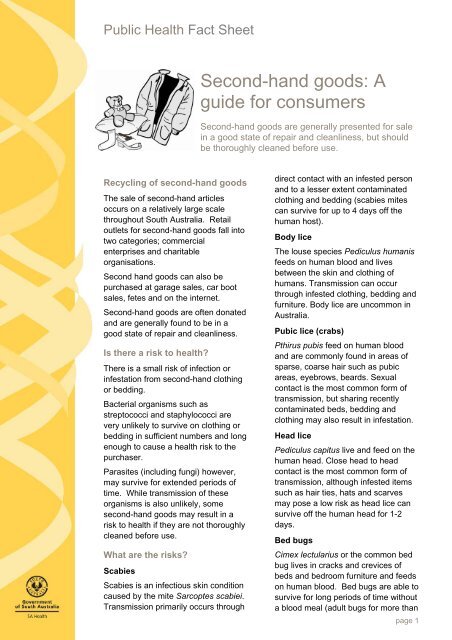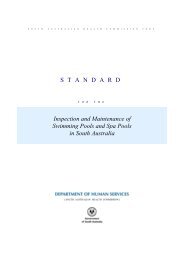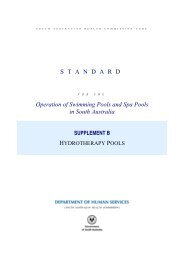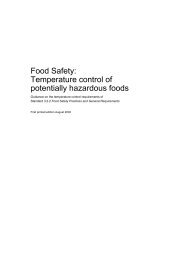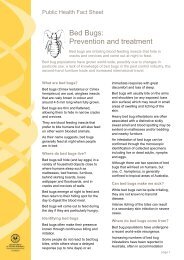Second-hand goods: A guide for consumers - SA Health - SA.gov.au
Second-hand goods: A guide for consumers - SA Health - SA.gov.au
Second-hand goods: A guide for consumers - SA Health - SA.gov.au
You also want an ePaper? Increase the reach of your titles
YUMPU automatically turns print PDFs into web optimized ePapers that Google loves.
Public <strong>Health</strong> Fact Sheet<br />
Recycling of second-<strong>hand</strong> <strong>goods</strong><br />
The sale of second-<strong>hand</strong> articles<br />
occurs on a relatively large scale<br />
throughout South Australia. Retail<br />
outlets <strong>for</strong> second-<strong>hand</strong> <strong>goods</strong> fall into<br />
two categories; commercial<br />
enterprises and charitable<br />
organisations.<br />
<strong>Second</strong> <strong>hand</strong> <strong>goods</strong> can also be<br />
purchased at garage sales, car boot<br />
sales, fetes and on the internet.<br />
<strong>Second</strong>-<strong>hand</strong> <strong>goods</strong> are often donated<br />
and are generally found to be in a<br />
good state of repair and cleanliness.<br />
Is there a risk to health?<br />
There is a small risk of infection or<br />
infestation from second-<strong>hand</strong> clothing<br />
or bedding.<br />
Bacterial organisms such as<br />
streptococci and staphylococci are<br />
very unlikely to survive on clothing or<br />
bedding in sufficient numbers and long<br />
enough to c<strong>au</strong>se a health risk to the<br />
purchaser.<br />
Parasites (including fungi) however,<br />
may survive <strong>for</strong> extended periods of<br />
time. While transmission of these<br />
organisms is also unlikely, some<br />
second-<strong>hand</strong> <strong>goods</strong> may result in a<br />
risk to health if they are not thoroughly<br />
cleaned be<strong>for</strong>e use.<br />
What are the risks?<br />
Scabies<br />
Scabies is an infectious skin condition<br />
c<strong>au</strong>sed by the mite Sarcoptes scabiei.<br />
Transmission primarily occurs through<br />
<strong>Second</strong>-<strong>hand</strong> <strong>goods</strong>: A<br />
<strong>guide</strong> <strong>for</strong> <strong>consumers</strong><br />
<strong>Second</strong>-<strong>hand</strong> <strong>goods</strong> are generally presented <strong>for</strong> sale<br />
in a good state of repair and cleanliness, but should<br />
be thoroughly cleaned be<strong>for</strong>e use.<br />
direct contact with an infested person<br />
and to a lesser extent contaminated<br />
clothing and bedding (scabies mites<br />
can survive <strong>for</strong> up to 4 days off the<br />
human host).<br />
Body lice<br />
The louse species Pediculus humanis<br />
feeds on human blood and lives<br />
between the skin and clothing of<br />
humans. Transmission can occur<br />
through infested clothing, bedding and<br />
furniture. Body lice are uncommon in<br />
Australia.<br />
Pubic lice (crabs)<br />
Pthirus pubis feed on human blood<br />
and are commonly found in areas of<br />
sparse, coarse hair such as pubic<br />
areas, eyebrows, beards. Sexual<br />
contact is the most common <strong>for</strong>m of<br />
transmission, but sharing recently<br />
contaminated beds, bedding and<br />
clothing may also result in infestation.<br />
Head lice<br />
Pediculus capitus live and feed on the<br />
human head. Close head to head<br />
contact is the most common <strong>for</strong>m of<br />
transmission, although infested items<br />
such as hair ties, hats and scarves<br />
may pose a low risk as head lice can<br />
survive off the human head <strong>for</strong> 1-2<br />
days.<br />
Bed bugs<br />
Cimex lectularius or the common bed<br />
bug lives in cracks and crevices of<br />
beds and bedroom furniture and feeds<br />
on human blood. Bed bugs are able to<br />
survive <strong>for</strong> long periods of time without<br />
a blood meal (adult bugs <strong>for</strong> more than<br />
page 1
Public <strong>Health</strong> Fact Sheet<br />
a year) and can be transported in<br />
furniture, bedding and clothing.<br />
Tinea<br />
Tinea (ringworm/athlete’s foot/jock<br />
itch) is a fungal infection of the skin,<br />
nails or hair which is highly<br />
contagious.<br />
Tinea can be transmitted from direct<br />
skin-to-skin contact or via<br />
contaminated clothing, footwear and<br />
surfaces such as shower floors. Shed<br />
skin scales can remain infectious <strong>for</strong><br />
prolonged periods in the environment.<br />
Impetigo (school sores)<br />
Skin infection c<strong>au</strong>sed by<br />
staphylococcus or streptococcus<br />
bacteria, or both. Impetigo is highly<br />
contagious through skin to skin contact<br />
and to a far lesser extent by <strong>hand</strong>ling<br />
clothing or other contaminated items.<br />
What do purchasers need to do?<br />
Many charitable organisations and<br />
second-<strong>hand</strong> dealers ensure that<br />
items are washed or clean be<strong>for</strong>e<br />
offering <strong>for</strong> sale to the public.<br />
As the risk to health associated with<br />
second-<strong>hand</strong> <strong>goods</strong> is very low,<br />
thorough and hygienic cleaning is all<br />
that is required to eliminate the risk of<br />
transmission.<br />
Most of the parasites/bacteria of<br />
concern can only survive away from<br />
the human host <strong>for</strong> a few days (except<br />
bed bugs and tinea) so contaminated<br />
items remain a risk <strong>for</strong> a very limited<br />
time.<br />
Washing second-<strong>hand</strong> clothing and<br />
bedding in hot water (hotter than 60 o C)<br />
and detergent kills these diseasec<strong>au</strong>sing<br />
organisms.<br />
Items that cannot be washed such as<br />
toys, pillows and delicates can be dry<br />
cleaned, sealed in a plastic bag <strong>for</strong> five<br />
days or placed on high heat in a<br />
tumble dryer <strong>for</strong> 10 minutes.<br />
What do I look <strong>for</strong>?<br />
Checking second-<strong>hand</strong> items<br />
thoroughly be<strong>for</strong>e purchase is a good<br />
idea.<br />
Bed bugs, lice and their eggs and/or<br />
waste products may be evident in the<br />
seams and creases of second-<strong>hand</strong><br />
<strong>goods</strong> (although they usually scurry<br />
away and hide when exposed to the<br />
light).<br />
Examining the article will give you an<br />
indication of its general cleanliness<br />
and quality but not necessarily reveal<br />
a health risk.<br />
Most of the parasites of concern are<br />
so tiny that they cannot be seen with<br />
the naked eye. For this reason it is<br />
important that all items are treated as<br />
potentially contaminated and washed<br />
be<strong>for</strong>e use.<br />
Items that are grossly soiled or<br />
contaminated should be discarded.<br />
Should <strong>goods</strong> be washed be<strong>for</strong>e<br />
sale?<br />
There are no specific laws in South<br />
Australia that require second-<strong>hand</strong><br />
dealers to clean <strong>goods</strong> be<strong>for</strong>e they are<br />
offered <strong>for</strong> sale to the public.<br />
It is common practice in many<br />
charitable organisations and second<strong>hand</strong><br />
stores to make items look clean,<br />
but the standard of cleaning practices<br />
may vary from store to store. Some<br />
stores wash all stock while others<br />
wash only items with noticeable marks<br />
or odour.<br />
Store cleaning policy may also vary<br />
depending on the item in question,<br />
such as washing all socks when they<br />
come into the shop but giving shoes<br />
just a wipe over (exterior surface) if<br />
they look ‘dirty’.<br />
page 2
Public <strong>Health</strong> Fact Sheet<br />
What about second-<strong>hand</strong><br />
jewellery?<br />
Although second-<strong>hand</strong> jewellery is<br />
often inserted into the body, it poses<br />
no more of a risk than clothing or<br />
bedding and requires the same<br />
standard of cleaning.<br />
Note: Jewellery used in new body<br />
piercing must be sterile.<br />
All second-<strong>hand</strong> jewellery items should<br />
be washed in warm water and<br />
detergent to remove any visible<br />
soiling, then rinsed in warm to hot<br />
running water be<strong>for</strong>e use.<br />
Contact<br />
Environmental <strong>Health</strong><br />
Public <strong>Health</strong><br />
<strong>SA</strong> <strong>Health</strong><br />
1st floor, Citi Centre Building<br />
11 Hindmarsh Square, Adelaide <strong>SA</strong> 5000<br />
PO Box 6, Rundle Mall<br />
Adelaide <strong>SA</strong> 5000<br />
Tel 08 8226 7100<br />
Fax 08 8226 7102<br />
ABN 97 643 356 590<br />
Email: public.health@health.sa.<strong>gov</strong>.<strong>au</strong><br />
Further in<strong>for</strong>mation Web: www.health.sa.<strong>gov</strong>.<strong>au</strong>/pehs/environ-<br />
health-index.htm<br />
• Your local council Environmental<br />
<strong>Health</strong> Officer<br />
© Department of <strong>Health</strong>,<br />
Government of South Australia.<br />
• The Department of <strong>Health</strong> on<br />
8226-7100 or go to our website:<br />
www.health.sa.<strong>gov</strong>.<strong>au</strong>/pehs/environhealth-index.htm<br />
All rights reserved.<br />
Last revised October 2008<br />
page 3


